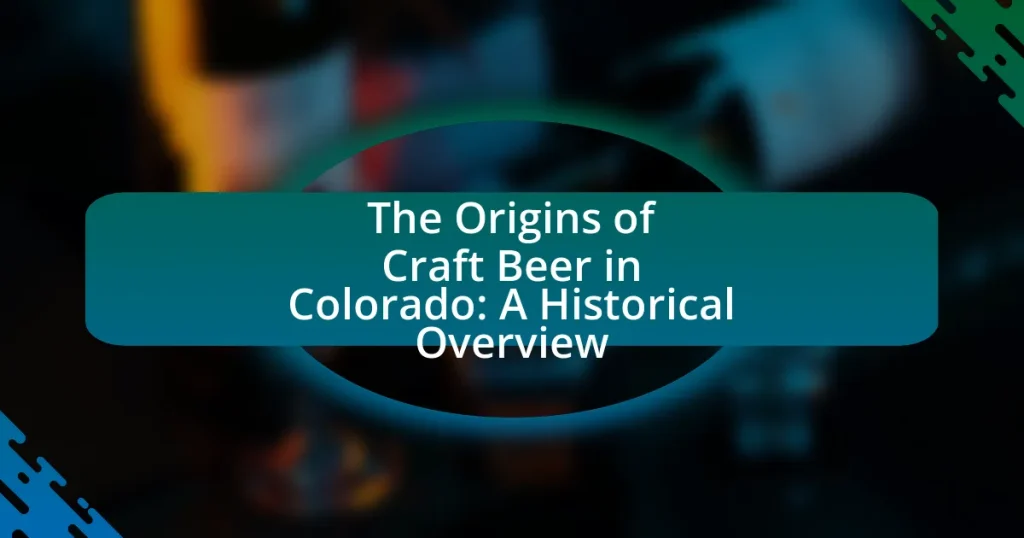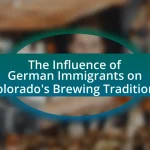The article provides a historical overview of craft beer in Colorado, tracing its roots back to the late 19th century with German immigrants who established early breweries. It highlights the significant milestones in the craft beer movement, including the legalization of homebrewing in the late 1970s and the founding of notable breweries like Boulder Beer Company. The piece discusses the impact of legislation on the brewing industry, key pioneers, and the evolution of consumer preferences, as well as the challenges faced by breweries today. Additionally, it explores the role of craft beer in local culture and economy, innovations in brewing, and future trends within Colorado’s vibrant craft beer scene.

What are the historical roots of craft beer in Colorado?
The historical roots of craft beer in Colorado trace back to the late 19th century when German immigrants began brewing lager in the state. These immigrants established some of the first breweries, such as the Tivoli Brewery in Denver, founded in 1859. The craft beer movement gained momentum in the 1970s and 1980s, with the opening of microbreweries like Boulder Beer Company in 1979, which is recognized as one of the first craft breweries in the state. By 2021, Colorado boasted over 400 craft breweries, reflecting its significant role in the national craft beer landscape.
How did the craft beer movement begin in Colorado?
The craft beer movement in Colorado began in the late 1970s when homebrewing became legal in the state, allowing enthusiasts to experiment with brewing techniques and flavors. This legal change spurred a wave of creativity and innovation, leading to the establishment of the first commercial craft breweries, such as Boulder Beer Company in 1979. By the mid-1980s, Colorado had become a hub for craft brewing, with the number of breweries increasing significantly, reflecting a growing consumer interest in diverse and high-quality beer options. The state’s favorable brewing conditions, including access to pure water and a culture that embraced local products, further fueled the movement’s growth.
What key events marked the start of craft brewing in the state?
The key events that marked the start of craft brewing in Colorado include the establishment of the Boulder Beer Company in 1979, which was one of the first craft breweries in the state, and the passing of the Colorado Craft Beer Act in 2012, which helped to promote and support local breweries. These events laid the foundation for Colorado’s vibrant craft beer culture, contributing to its reputation as a leading state in craft brewing.
Who were the pioneers of craft beer in Colorado?
The pioneers of craft beer in Colorado include Charlie Papazian, who founded the American Homebrewers Association in 1978 and established the first craft brewery in Colorado, Boulder Beer Company, in 1979. Additionally, the establishment of Wynkoop Brewing Company in 1988 by John Hickenlooper and his partners marked a significant milestone in the state’s craft beer movement. These individuals and their contributions laid the foundation for Colorado’s vibrant craft beer culture, which has grown to include over 400 breweries as of 2023.
What role did legislation play in the development of craft beer?
Legislation significantly influenced the development of craft beer by establishing a regulatory framework that allowed small breweries to operate legally and thrive. The repeal of Prohibition in 1933, through the 21st Amendment, marked a pivotal moment, as it permitted the production and sale of beer, laying the groundwork for the craft beer movement. Additionally, the introduction of the Small Business Job Protection Act in 1996, which reduced federal excise taxes for small breweries, further incentivized the growth of craft breweries by making it financially viable for entrepreneurs to enter the market. These legislative changes created an environment that encouraged innovation and diversity in beer production, leading to the flourishing craft beer industry we see today.
How did the repeal of Prohibition affect Colorado’s brewing industry?
The repeal of Prohibition in 1933 revitalized Colorado’s brewing industry by allowing breweries to operate legally again. Prior to the repeal, many breweries had closed or shifted to producing non-alcoholic products, resulting in a significant decline in the industry. After Prohibition ended, Colorado saw a resurgence in brewing activity, with established breweries reopening and new ones emerging, contributing to the state’s rich beer culture. By the late 20th century, Colorado became known for its craft beer scene, with the state hosting numerous breweries and beer festivals, reflecting the long-term impact of the repeal on the industry.
What laws and regulations have shaped craft brewing in Colorado?
The laws and regulations that have shaped craft brewing in Colorado include the Colorado Liquor Code, which was established in 1935, allowing for the legal sale of beer and liquor, and the 2008 legislation that permitted the sale of full-strength beer in grocery stores. Additionally, the 2012 law allowing breweries to sell beer directly to consumers through taprooms significantly impacted the craft brewing landscape. These regulations have fostered a supportive environment for craft breweries, contributing to Colorado’s reputation as a craft beer hub, with over 400 breweries operating in the state as of 2023.
What are the significant milestones in Colorado’s craft beer history?
The significant milestones in Colorado’s craft beer history include the establishment of the first craft brewery, Boulder Beer Company, in 1979, which marked the beginning of the craft beer movement in the state. In 1988, the Colorado Brewers Guild was formed, promoting the interests of local breweries and fostering collaboration. The 1990s saw rapid growth, with the number of breweries increasing from 10 to over 100 by the end of the decade. In 2011, Colorado became the first state to host the Great American Beer Festival, further solidifying its reputation as a craft beer hub. By 2020, Colorado had over 400 breweries, making it one of the leading states in craft beer production in the United States.
What major breweries contributed to the craft beer landscape?
Major breweries that contributed to the craft beer landscape include Sierra Nevada Brewing Co., New Belgium Brewing Company, and Stone Brewing. Sierra Nevada, founded in 1980, is credited with popularizing pale ales and has influenced many craft brewers with its innovative approaches. New Belgium, established in 1991, is known for its Fat Tire Amber Ale and commitment to sustainability, shaping the craft beer movement significantly. Stone Brewing, founded in 1996, is recognized for its bold flavors and aggressive marketing, helping to define the West Coast IPA style. These breweries have played pivotal roles in the growth and evolution of craft beer, establishing benchmarks for quality and creativity in the industry.
How did these breweries influence local culture and economy?
Breweries significantly influenced local culture and economy by fostering community engagement and creating jobs. The establishment of craft breweries in Colorado led to the development of a vibrant social scene, where locals gathered for events, tastings, and festivals, enhancing community ties. Economically, these breweries contributed to job creation; for instance, the Colorado Brewers Guild reported that the craft beer industry supported over 10,000 jobs and generated substantial tax revenue, which in turn funded local services. Additionally, breweries often sourced ingredients locally, stimulating the agricultural sector and promoting regional products, further embedding the breweries into the local economy and culture.
What innovations did they bring to the brewing process?
Craft brewers in Colorado introduced several innovations to the brewing process, including the use of high-quality, locally sourced ingredients and the implementation of small-batch brewing techniques. These practices allowed for greater experimentation with flavors and styles, leading to the development of unique craft beers that reflected the local terroir. Additionally, advancements in brewing technology, such as temperature control and fermentation monitoring, enhanced the consistency and quality of the final product. These innovations contributed to the rapid growth of the craft beer movement in Colorado, establishing it as a significant player in the national beer landscape.
What events and festivals celebrate craft beer in Colorado?
Colorado hosts several prominent events and festivals that celebrate craft beer, including the Great American Beer Festival, held annually in Denver, which is one of the largest beer festivals in the United States, featuring thousands of beers from hundreds of breweries. Another significant event is the Colorado Brewers’ Festival in Fort Collins, showcasing local breweries and offering tastings, food pairings, and live music. Additionally, the Denver Beer Fest, coinciding with the Great American Beer Festival, includes various beer-related events across the city. These festivals highlight Colorado’s rich craft beer culture, which has grown significantly since the state’s first craft brewery opened in 1979.
How do these events promote local breweries and craft beer culture?
Events promote local breweries and craft beer culture by providing a platform for community engagement and showcasing unique local products. These gatherings often feature tastings, workshops, and competitions that highlight the distinct flavors and brewing techniques of local breweries, fostering appreciation among attendees. For instance, events like the Great American Beer Festival have historically attracted thousands of visitors, significantly boosting local brewery visibility and sales. Additionally, such events create networking opportunities for brewers, encouraging collaboration and innovation within the craft beer community, which further enriches the local beer culture.
What impact do they have on tourism and community engagement?
Craft breweries significantly enhance tourism and community engagement in Colorado. They attract visitors seeking unique local experiences, contributing to the state’s economy; for instance, craft breweries generated over $3 billion in economic impact in 2021. Additionally, these breweries foster community connections through events, collaborations, and local sourcing, strengthening social ties and promoting local culture. The rise of craft beer festivals and brewery tours further exemplifies how these establishments serve as focal points for community interaction and tourism growth.

How has the craft beer scene evolved in Colorado over the years?
The craft beer scene in Colorado has evolved significantly since the late 1970s, transitioning from a few small breweries to a thriving industry with over 400 breweries as of 2023. This growth was catalyzed by the 1978 legalization of homebrewing, which encouraged experimentation and innovation among beer enthusiasts. The establishment of the Colorado Brewers Guild in 1998 further supported local breweries by promoting collaboration and advocacy. Additionally, the state’s diverse geography and climate have allowed for a wide range of beer styles, contributing to Colorado’s reputation as a craft beer destination. The state’s craft beer production has also been recognized nationally, with Colorado breweries winning numerous awards at prestigious competitions, solidifying their place in the craft beer landscape.
What trends have emerged in Colorado’s craft beer industry?
Recent trends in Colorado’s craft beer industry include a significant rise in the popularity of sour beers, an increase in the use of local ingredients, and a growing focus on sustainability practices. The craft beer scene has seen a 25% increase in sour beer production from 2019 to 2022, reflecting consumer demand for unique flavors. Additionally, breweries are increasingly sourcing hops and grains from local farms, which supports the regional economy and enhances freshness. Sustainability efforts are also on the rise, with many breweries adopting eco-friendly practices such as water conservation and waste reduction, aligning with consumer preferences for environmentally responsible products.
How have consumer preferences influenced brewing styles?
Consumer preferences have significantly influenced brewing styles by driving the demand for diverse flavors and innovative techniques. As craft beer gained popularity in Colorado, consumers began favoring unique and bold flavors, prompting brewers to experiment with various ingredients and brewing methods. For instance, the rise of hop-forward IPAs and sour beers reflects consumer interest in complex taste profiles. Additionally, the trend towards local and sustainable sourcing has led breweries to incorporate regional ingredients, further shaping the brewing landscape. This shift in consumer preferences has resulted in a vibrant craft beer culture that prioritizes quality and creativity, as evidenced by the growth of over 400 craft breweries in Colorado by 2021, showcasing the direct impact of consumer choices on brewing styles.
What role does sustainability play in modern craft brewing?
Sustainability plays a crucial role in modern craft brewing by promoting environmentally friendly practices that reduce waste and conserve resources. Craft breweries often implement strategies such as sourcing local ingredients, utilizing renewable energy, and recycling water to minimize their ecological footprint. For instance, a study by the Brewers Association highlights that 75% of craft breweries engage in some form of sustainability initiative, demonstrating a commitment to responsible brewing practices. This focus on sustainability not only enhances the quality of the beer but also appeals to environmentally conscious consumers, thereby driving market growth and fostering community support.
What challenges do Colorado craft breweries face today?
Colorado craft breweries face significant challenges today, including increased competition, regulatory hurdles, and supply chain disruptions. The craft beer market has become saturated, with over 400 breweries in Colorado alone, making it difficult for individual breweries to stand out and maintain profitability. Additionally, stringent regulations regarding alcohol production and distribution can complicate operations and increase costs. Supply chain issues, particularly in sourcing ingredients like hops and malt, have been exacerbated by global disruptions, impacting production timelines and costs. These factors collectively threaten the sustainability and growth of craft breweries in Colorado.
How do market competition and economic factors impact small breweries?
Market competition and economic factors significantly impact small breweries by influencing their pricing strategies, market share, and overall sustainability. Increased competition from both large-scale breweries and other craft breweries can lead to price wars, forcing small breweries to either lower their prices or enhance their product quality to attract customers. Economic factors, such as consumer spending power and trends in disposable income, directly affect sales; for instance, during economic downturns, consumers may prioritize essential goods over craft beer, impacting small breweries’ revenues. Additionally, data from the Brewers Association indicates that the craft beer market has seen a growth rate of 4% in volume sales, highlighting the importance of adapting to competitive pressures and economic conditions to thrive in the industry.
What strategies are breweries using to adapt to these challenges?
Breweries are employing various strategies to adapt to challenges such as market competition and changing consumer preferences. These strategies include diversifying product offerings by introducing new styles and flavors, enhancing direct-to-consumer sales through taprooms and online platforms, and focusing on sustainability practices to appeal to environmentally conscious consumers. For instance, many breweries are now incorporating local ingredients to create unique brews that resonate with regional tastes, which not only differentiates their products but also supports local agriculture. Additionally, breweries are leveraging social media and digital marketing to engage with customers and build brand loyalty, which has become increasingly important in a competitive landscape.
What can we expect for the future of craft beer in Colorado?
The future of craft beer in Colorado is expected to see continued growth and innovation, driven by consumer demand for unique flavors and local products. As of 2023, Colorado boasts over 400 craft breweries, making it one of the leading states in craft beer production. This trend is supported by a strong local culture that values artisanal products and sustainability, with many breweries focusing on environmentally friendly practices. Additionally, the state’s favorable regulations and supportive community initiatives are likely to foster further expansion and diversification in the craft beer market.
How might emerging technologies shape the brewing process?
Emerging technologies are likely to significantly enhance the brewing process by improving efficiency, consistency, and quality. For instance, advancements in automation and data analytics allow brewers to monitor fermentation conditions in real-time, leading to more precise control over flavor profiles and reducing the risk of batch variability. Additionally, innovations such as artificial intelligence can optimize ingredient sourcing and recipe formulation, enabling brewers to create unique flavors while minimizing waste. Research indicates that breweries adopting these technologies can increase production efficiency by up to 30%, demonstrating the tangible benefits of integrating modern tools into traditional brewing practices.
What potential growth areas exist for craft breweries in Colorado?
Potential growth areas for craft breweries in Colorado include expanding into underserved markets, increasing distribution channels, and enhancing product diversity. The state’s craft beer market has seen a 10% annual growth rate, indicating a strong consumer demand. Additionally, the rise of tourism in Colorado, which attracted over 86 million visitors in 2022, presents opportunities for breweries to tap into the tourism sector by offering brewery tours and tastings. Furthermore, the growing interest in sustainable and locally sourced products allows craft breweries to innovate with organic ingredients and eco-friendly practices, aligning with consumer preferences for sustainability.
What are the best practices for enjoying Colorado craft beer?
To enjoy Colorado craft beer, it is essential to explore a variety of local breweries, as Colorado is home to over 400 craft breweries, offering diverse styles and flavors. Sampling different beer styles, such as IPAs, stouts, and sours, enhances the experience, allowing individuals to appreciate the unique characteristics of each brew. Pairing craft beer with local cuisine, which often features ingredients sourced from Colorado farms, can elevate the tasting experience. Additionally, participating in brewery tours provides insight into the brewing process and the history of craft beer in Colorado, enriching the overall enjoyment. Engaging with the craft beer community through festivals and events fosters a deeper appreciation for the culture surrounding Colorado’s craft beer scene.
How can consumers support local breweries effectively?
Consumers can effectively support local breweries by purchasing their products directly from the brewery, attending events, and promoting them on social media. Direct purchases ensure that a larger portion of the revenue goes to the brewery, as opposed to retail markups. Attending brewery events, such as tastings or festivals, increases foot traffic and visibility, which can lead to higher sales. Promoting local breweries on social media helps raise awareness and attract new customers, contributing to the brewery’s growth. According to the Brewers Association, local breweries contribute significantly to the economy, with craft breweries generating over $82 billion in economic impact in the U.S. in 2021, highlighting the importance of consumer support.
What tips are there for pairing craft beer with food?
To effectively pair craft beer with food, consider matching the beer’s flavor profile with the dish’s characteristics. For example, hoppy IPAs complement spicy foods, while malty stouts enhance rich, chocolate desserts. This principle is supported by the Beer and Food Pairing Guide, which emphasizes balancing intensity and flavors. Additionally, contrasting flavors can create a dynamic experience; for instance, a sour beer can cut through the richness of fatty dishes.


